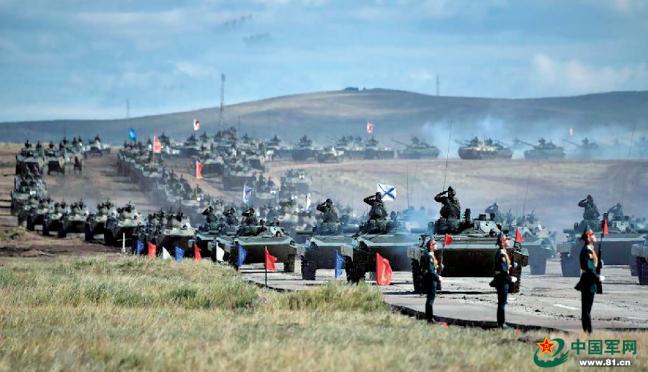
By Qu Xiaobo
The armed forces of Russian Federation carried out the “Tsentr-2019 (Center-2019)” strategic exercise from September 16 to 21 at eight training ranges across Russia, in Kazakhstan and Kyrgyzstan, and at the No.201 military base in Tajikistan as well. The exercise was aimed to deepen the military cooperation among participating countries and demonstrate their readiness to fight international terrorism and safeguard regional security and stability in central Asia.
“Upgraded” tactics more suitable for actual combat
Russian media reported that “Tsentr-2019” included many tactical subjects that demonstrated the latest achievements in Russian military’s equipment system and tactical innovation. Subjects concerning high-tech support, high-difficulty handling and fast response to emergency have created a strong real-combat atmosphere.
The independent participation of Russian troops of radiological, chemical and biological defense has become a highlight of the exercise. Not only independently completing specialized subjects including fast response, cleanup of contaminated areas and self-defense, they also merged into various operations units to make sure that combat clusters could successfully accomplish battlefield setup. The troops of radiological, chemical and biological defense handled a series of CBRN (chemical, biological and radiological or nuclear defense) risks in modern warfare conditions during the exercise, and their application of tactics was “much more skillful than on the Middle East battlefield”, said the director of the troops.
High-tech results were also applied in the exercise. For instance, regarding logistics and technology support, the unmoored vessel fueling system could fuel the vessels 1,000m away from shore; in forced landing exercise of warplanes on highway, the new automatic fueling system could inject 500 liters of oil per minute and fuel six warplanes simultaneously within 10 minutes.
The military-local cooperation mode also better met the requirements for actual combat. A 2.3km dismountable field pipeline was laid at the bottom of the Volga River based on the national fuel trunk pipe, to realize the daily average supply capacity of 1,500 tons, largely improving the replenishment efficiency.
In the field of actual combat, the super-long-distance maneuvering of Mi-8 helicopters, road takeoff and landing of Su-30MKI and other heavy warplanes, and large-formation, high-density and low-altitude landing of IL-76 transport aircraft all tested the Russian troops’ new technologies and tactics.
At Donguz training range, the Russian electronic warfare detachment used “civilian” jamming equipment, Krasukha electronic warfare system and the new-generation Borisoglebsk-2 equipment to carry out air defense, electronic suppression and other subjects. Among them, the GSM communication suppression using unmanned aerial vehicle (UAV) as the carrier and the application of airport air defense interference system demonstrated strong capability of electronic warfare.
Touchstone of war preparedness
The exercise was regarded as a summering presentation of Russian military training and reform achievements in this year, for which the Russian side released detailed and timely information. The greater transparency reflected Moscow’s military confidence and demonstrated to the world its military strength to safeguard national rights and interests.
Analysts said that Russia envisioned security threat as “the combination of terrorism, extremist force and modern enemy countries”, which is of high realistic significance and reflects its thought for war preparedness and the direction of consistently developing modern regular forces.
The Russian troops’ professionalism in responding to battlefield emergencies in a rapid and procedure-based manner heartened the public, said a Russian expert. In addition to stressing “hard confrontation” on the battlefield, subjects like electronic warfare and psychological warfare that the general political bureau participated in added more “hybrid warfare” factors to the exercise. Meanwhile, the debut of automatic ammunition reloading, container-style modular chemical analysis lab and other devices refuted the west’s doubt about the modernization of Russia’s military equipment.
Some western media paid much attention on the “Tsentr-2019” exercise as well. Apart from taking this as an opportunity to hype up the “military threat theory”, some of them held that Russia’s modern warfare concept and design of “imaginary rivals” are more mature and the military’s actual combat level and hybrid warfare capability are constantly improved. This strategic military exercise gave the outside world a more direct impression of what Russia has achieved in war preparedness. “The exercise strengthened the participating countries’ confidence and friendship, and deterred terrorists and other enemy forces,” said Bulgakov, the Deputy Minister of Defence of the Russian Federation.













